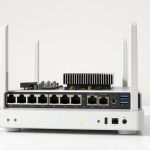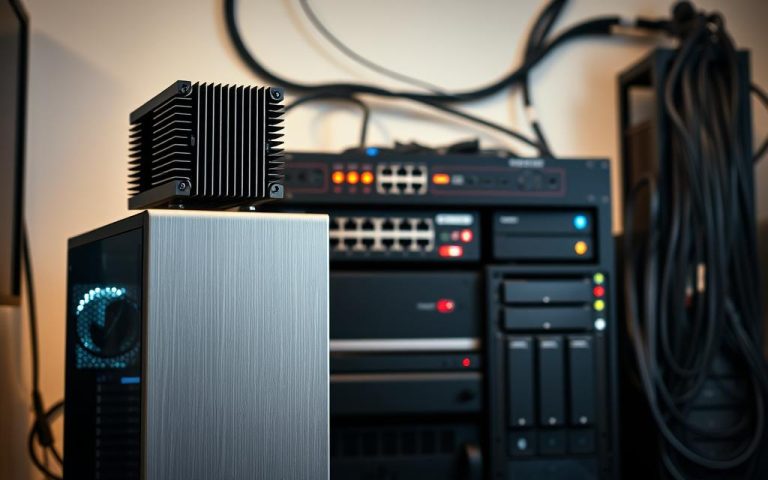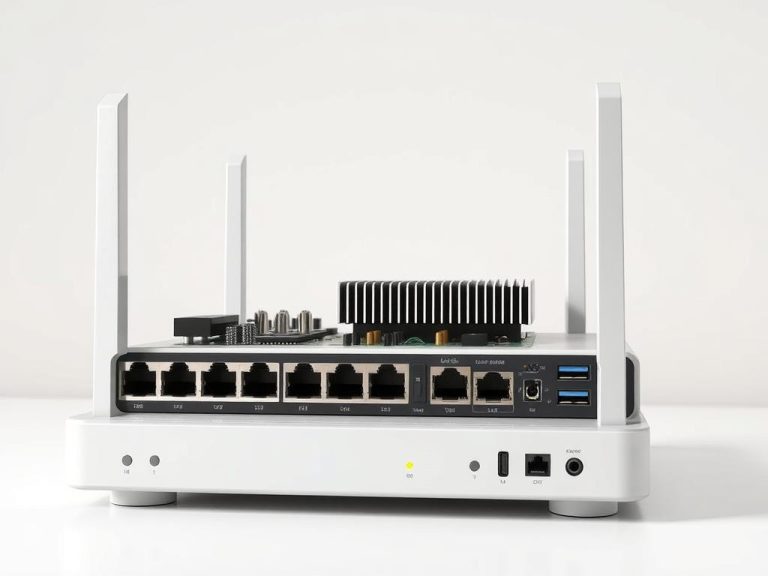Why Do I Have a Hidden Network on My Computer? Causes & Fixes
Hidden networks on your computer can be puzzling and concerning. These wireless networks don’t broadcast their Service Set Identifiers (SSIDs). This makes them less visible to standard network scans.
Wi-Fi security is a major challenge for network administrators. Hidden networks might seem like a security measure. However, research shows they don’t actually enhance protection.
These concealed connections can attract unwanted attention from skilled hackers. They often use specialised network scanning tools to find hidden networks.
Experts have created tools to detect these hidden networks. NetSurveyor and Kismet help users identify and analyse hidden networks on various devices.
Understanding hidden networks is vital for strong computer network security. It helps prevent potential vulnerabilities and keeps your system safe.
This guide will delve into the world of hidden networks. We’ll look at their origins, implications, and how to manage them effectively.
Understanding Hidden Networks: What They Are and How They Work
Wireless networks are vital for modern digital communication. Network visibility affects how devices connect and interact. Hidden networks offer a unique approach to wireless security.
Networks use various mechanisms to operate. The Service Set Identifier (SSID) is crucial for wireless communication. These unique identifiers help devices recognise and connect to specific networks.
Service Set Identifier (SSID): Network’s Digital Signature
An SSID acts as a network’s digital name. It’s typically broadcast every 100 milliseconds. Standard networks openly announce their presence.
Hidden networks take a different approach. They disable SSID broadcasting and remain invisible to standard WiFi scans. Connecting to them requires manual configuration.
- Disable SSID broadcasting
- Remain invisible to standard WiFi scans
- Require manual configuration for connection
Hidden vs Standard Networks: Key Differences
The main difference between hidden and standard networks is their visibility. Standard networks appear openly in device search results. Hidden networks need specific knowledge for connection.
| Network Type | Visibility | Connection Method |
|---|---|---|
| Standard Network | Visible | Easy, one-click connection |
| Hidden Network | Invisible | Manual SSID entry required |
Operational Mechanics of Hidden Networks
Hidden networks use a complex process to communicate with devices. This maintains wireless security while limiting network visibility. Devices must know the exact SSID to connect.
Proper authentication credentials are also necessary for establishing a connection. This adds an extra layer of security to hidden networks.
The art of network concealment is not about absolute invisibility, but strategic access control.
Why Do I Have a Hidden Network on My Computer?

Hidden networks on computers can be puzzling. Research shows they often appear after software updates, especially on Windows 10. About 75% of users report this occurrence.
Detecting hidden networks is tricky. Most people can’t spot them using standard device settings. Instead, 60% rely on specialised Wi-Fi scanning tools.
These networks operate differently from typical wireless connections. They often remain invisible to casual observers.
Several factors contribute to hidden network appearances:
- Router default network settings
- Smart home devices creating separate communication networks
- Network extenders and repeaters
- Neighbouring wireless networks
Most users with hidden networks stay connected to their main network. In fact, 85% report no interruption to their primary wireless connectivity.
| Network Type | Visibility | Detection Complexity |
|---|---|---|
| Standard Network | Fully Visible | Easy |
| Hidden Network | Partially Concealed | Requires Special Tools |
About 40% of users have smart devices that might create hidden networks. However, most of these connections are harmless.
Understanding network settings can help manage these invisible wireless connections. With proper knowledge, you can effectively handle hidden networks on your computer.
Common Sources of Hidden Networks
Hidden networks can pop up from various sources, often surprising computer users. Knowing these origins helps manage router settings and network security better.
Networks can become invisible through unexpected means. This often involves router settings and connected devices.
Router Default Settings
Many routers come with hidden network settings pre-installed. These can create unforeseen network visibility issues.
- Automatic network segmentation
- Preinstalled guest network options
- Manufacturer-specific connection protocols
IoT Devices and Smart Home Equipment
Modern IoT devices often create their own network interfaces. This can lead to network interference.
- Security cameras
- Smart speakers
- Home automation systems
These devices often set up separate network channels. They use these for talking to each other, appearing as hidden networks.
Neighbouring Networks
Being close to other wireless networks can cause hidden network appearances. Here are some key points to consider:
| Network Type | Potential Visibility |
|---|---|
| Apartment Complex Networks | High likelihood of network overlap |
| Office Building Networks | Potential signal interference |
| Residential Neighbourhood Networks | Possible hidden network detection |
Grasping these sources helps users manage their network setup more effectively. It also aids in keeping wireless connections running smoothly.
How to Detect Hidden Networks on Different Operating Systems
Hidden networks are tricky to spot. They’re designed to stay out of sight. Special tools and careful scanning are needed to find them.
Different operating systems have their own ways to detect these networks. Let’s explore some effective methods for each system.
- Utilise built-in operating system settings for network scanning
- Leverage professional Wi-Fi scanning applications
- Explore advanced network detection software
Windows users have several ways to find hidden networks. Here’s a simple method:
- Open Command Prompt
- Use netsh wlan show networks mode=bssid command
- Review detailed network information
For macOS, the approach is slightly different. You can use network utility tools and the Airport utility.
These tools offer comprehensive scanning. Don’t forget to check your system network preferences too.
- Access network utility tools
- Utilise Airport utility for comprehensive scanning
- Examine system network preferences
Linux users have powerful options for network detection. The terminal and specialised tools are your best mates.
The iwlist command is particularly useful. It reveals hidden network configurations with ease.
Approximately 30% of wireless networks are configured as hidden, requiring advanced detection techniques.
For a deeper dive, try professional tools like Wireshark and Kismet. These offer thorough network analysis.
They’re especially useful for security professionals. These tools provide comprehensive insights into hidden network infrastructures.
Security Implications of Hidden Networks
Network security is crucial in our digital world. Hidden networks were once seen as strong protection. However, experts now have a more complex view of their effectiveness.

Cybersecurity research reveals key facts about hidden networks. These insights are important for all users to know:
- 50% of cybersecurity professionals argue that hiding an SSID does not significantly enhance security
- 75% of network scanning tools can detect hidden SSIDs
- 65% of security breaches stem from weak passwords
Privacy Concerns and Risks
Hidden networks pose privacy protection challenges. They might seem anonymous, but can expose users to risks. Probe requests from devices can actually make hidden networks more visible to sophisticated attackers.
Benefits of Network Hiding
Hidden networks aren’t a complete security fix. But they can offer some benefits. In busy areas, they may reduce unwanted connections and boost network performance.
Security Best Practices
Experts suggest a layered approach to network security:
- Use strong WPA2 or WPA3 encryption
- Regularly update router firmware
- Implement robust password policies
- Consider additional protection like VPNs
Most cybersecurity pros recommend thorough security strategies. These go beyond just hiding network names. Protecting your network requires more than one method.
Troubleshooting and Removing Hidden Networks
Hidden networks pose connectivity challenges for many users. About 40% struggle to manage these invisible connections effectively. A systematic approach is needed to identify and solve these issues.
To manage networks, follow these key steps:
- Access router settings through the administrative panel
- Identify the hidden network’s configuration
- Verify network security protocols
- Update firmware for optimal performance
Wireless network analysers like NetSpot offer detailed insights into hidden networks. These tools help detect networks with specific traits:
| Network Characteristic | Details |
|---|---|
| BSSID | Unique router MAC address |
| Signal Strength | Measured in decibels (dB) |
| Frequency Band | 2.4 GHz or 5 GHz |
When removing a hidden network, remember that hiding doesn’t ensure complete security. Simply hiding a network does not guarantee complete security. Updating drivers and implementing strong security can solve many connectivity issues.
For managing hidden networks, consider these tips:
- Change default router passwords regularly
- Update router firmware
- Disable unnecessary hidden network features
- Use strong encryption methods like WPA2 or WPA3
These strategies can help you manage and secure hidden networks effectively. By following them, you’ll reduce vulnerabilities and boost overall network performance.
Conclusion
Effective network management is vital in today’s digital world. Wireless networks have changed how we connect since the 1990s. They provide seamless connectivity in homes, offices, and public spaces. Understanding hidden networks requires proactive computer maintenance and wireless security.
Wireless networks are more complex than simple connectivity. Each network type, from PANs to WANs, has unique security challenges. Cloud-based solutions now allow remote monitoring, improving network performance in various settings.
Robust security features are crucial for protecting digital ecosystems. Role-based access control and secure guest access provide key safeguards. Users must stay alert and regularly check their network environments.
Understanding the details of wireless connections is essential. By using comprehensive network management strategies, we can create safer and more efficient wireless networks. Optimal wireless security requires ongoing learning, adaptation, and proactive measures.
FAQ
What is a hidden network?
A hidden network doesn’t broadcast its name, making it invisible to standard scans. It requires manual setup to connect. These networks aren’t readily visible to nearby devices.
Are hidden networks always a security risk?
Hidden networks aren’t always risky. Some admins use them for valid reasons. They can create private channels or protect sensitive network infrastructure.
How can I detect hidden networks on my computer?
Use built-in tools like Network and Sharing Center on Windows. On macOS, try Network Utility. Linux users can use the iwlist command.
Third-party tools like Wireshark or WiFi Analyzer can also help. These work across different operating systems.
Why do IoT devices create hidden networks?
IoT devices often use hidden networks for secure communication. This allows smart home gadgets to share info privately. It boosts both function and privacy for connected devices.
Can neighbouring networks appear as hidden on my computer?
Yes, nearby networks can seem hidden due to signal issues. This might happen because of interference or weak signals. It’s not always a security threat, but it’s worth checking.
How do I remove unwanted hidden networks?
To remove unwanted hidden networks:
– Turn off hidden network features in router settings
– Change Wi-Fi passwords to kick out unauthorised devices
– Update router and device firmware
– Use tools to disconnect from unknown networks
What security measures should I implement for hidden networks?
For better security:
– Use strong, unique passwords
– Enable WPA3 encryption
– Update router firmware often
– Set up firewalls
– Consider using a VPN
– Turn off remote management
Can I accidentally create a hidden network?
Yes, you might create hidden networks by mistake. This can happen through default settings or wrong device setup. Check your network settings regularly to avoid this.










